毕业论文_浅议英语歌曲歌谣在小学英语课堂中的应用
- 格式:doc
- 大小:59.50 KB
- 文档页数:7
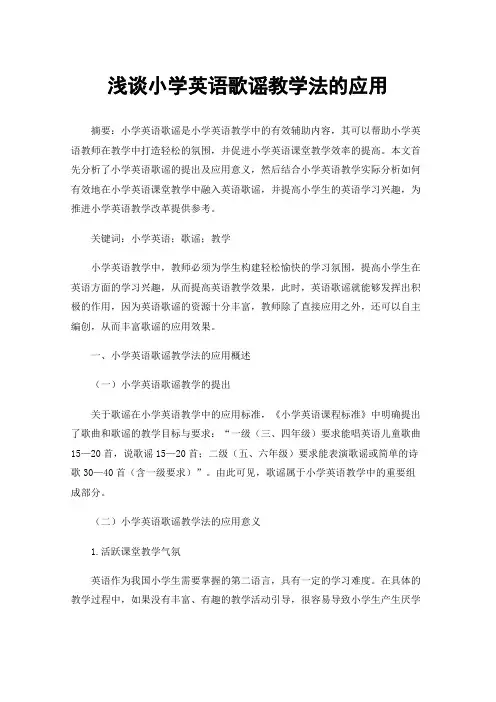
浅谈小学英语歌谣教学法的应用摘要:小学英语歌谣是小学英语教学中的有效辅助内容,其可以帮助小学英语教师在教学中打造轻松的氛围,并促进小学英语课堂教学效率的提高。
本文首先分析了小学英语歌谣的提出及应用意义,然后结合小学英语教学实际分析如何有效地在小学英语课堂教学中融入英语歌谣,并提高小学生的英语学习兴趣,为推进小学英语教学改革提供参考。
关键词:小学英语;歌谣;教学小学英语教学中,教师必须为学生构建轻松愉快的学习氛围,提高小学生在英语方面的学习兴趣,从而提高英语教学效果,此时,英语歌谣就能够发挥出积极的作用,因为英语歌谣的资源十分丰富,教师除了直接应用之外,还可以自主编创,从而丰富歌谣的应用效果。
一、小学英语歌谣教学法的应用概述(一)小学英语歌谣教学的提出关于歌谣在小学英语教学中的应用标准,《小学英语课程标准》中明确提出了歌曲和歌谣的教学目标与要求:“一级(三、四年级)要求能唱英语儿童歌曲15—20首,说歌谣15—20首;二级(五、六年级)要求能表演歌谣或简单的诗歌30—40首(含一级要求)”。
由此可见,歌谣属于小学英语教学中的重要组成部分。
(二)小学英语歌谣教学法的应用意义1.活跃课堂教学气氛英语作为我国小学生需要掌握的第二语言,具有一定的学习难度。
在具体的教学过程中,如果没有丰富、有趣的教学活动引导,很容易导致小学生产生厌学情绪。
歌谣的节奏简短、明快,歌词内容丰富、有趣,旋律优美、动听,可以为英语课堂学习构建轻松、愉悦的体验,吸引小学生积极参与英语学习。
2.化解课堂教学难点小学英语课本中出现的歌谣内容,以及教师从课外平台中搜集的英语歌谣,往往都与课堂的教学内容相关。
由于很多歌谣的内容与课堂教学的重难点相辅相成,学生在学唱歌谣的同时,也是对课本词汇、语法和句型的巩固。
这种学习方式轻松自由,可以使学生轻松掌握课堂教学难点。
3.强化学生英语记忆相较传统的死记硬背模式,歌谣运用音乐中独有的旋律、歌词等形象化的元素有效刺激小学生的大脑;借助强烈的节奏感、独有的押韵等音乐特性,让小学生对英语词汇知识产生长久的记忆效果[1]。
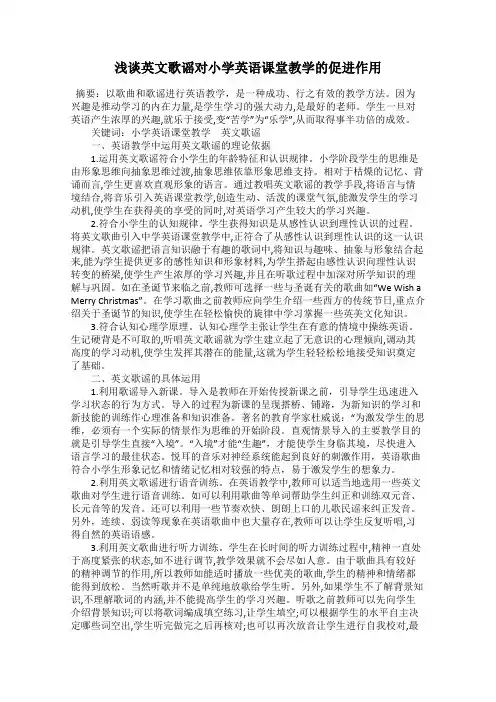
浅谈英文歌谣对小学英语课堂教学的促进作用摘要:以歌曲和歌谣进行英语教学,是一种成功、行之有效的教学方法。
因为兴趣是推动学习的内在力量,是学生学习的强大动力,是最好的老师。
学生一旦对英语产生浓厚的兴趣,就乐于接受,变“苦学”为“乐学”,从而取得事半功倍的成效。
关键词:小学英语课堂教学英文歌谣一、英语教学中运用英文歌谣的理论依据1.运用英文歌谣符合小学生的年龄特征和认识规律。
小学阶段学生的思维是由形象思维向抽象思维过渡,抽象思维依靠形象思维支持。
相对于枯燥的记忆、背诵而言,学生更喜欢直观形象的语言。
通过教唱英文歌谣的教学手段,将语言与情境结合,将音乐引入英语课堂教学,创造生动、活泼的课堂气氛,能激发学生的学习动机,使学生在获得美的享受的同时,对英语学习产生较大的学习兴趣。
2.符合小学生的认知规律。
学生获得知识是从感性认识到理性认识的过程。
将英文歌曲引入中学英语课堂教学中,正符合了从感性认识到理性认识的这一认识规律。
英文歌谣把语言知识融于有趣的歌词中,将知识与趣味、抽象与形象结合起来,能为学生提供更多的感性知识和形象材料,为学生搭起由感性认识向理性认识转变的桥梁,使学生产生浓厚的学习兴趣,并且在听歌过程中加深对所学知识的理解与巩固。
如在圣诞节来临之前,教师可选择一些与圣诞有关的歌曲如“We Wish a Merry Christmas”。
在学习歌曲之前教师应向学生介绍一些西方的传统节日,重点介绍关于圣诞节的知识,使学生在轻松愉快的旋律中学习掌握一些英美文化知识。
3.符合认知心理学原理。
认知心理学主张让学生在有意的情境中操练英语。
生记硬背是不可取的,听唱英文歌谣就为学生建立起了无意识的心理倾向,调动其高度的学习动机,使学生发挥其潜在的能量,这就为学生轻轻松松地接受知识奠定了基础。
二、英文歌谣的具体运用1.利用歌谣导入新课。
导入是教师在开始传授新课之前,引导学生迅速进入学习状态的行为方式。
导入的过程为新课的呈现搭桥、铺路,为新知识的学习和新技能的训练作心理准备和知识准备。
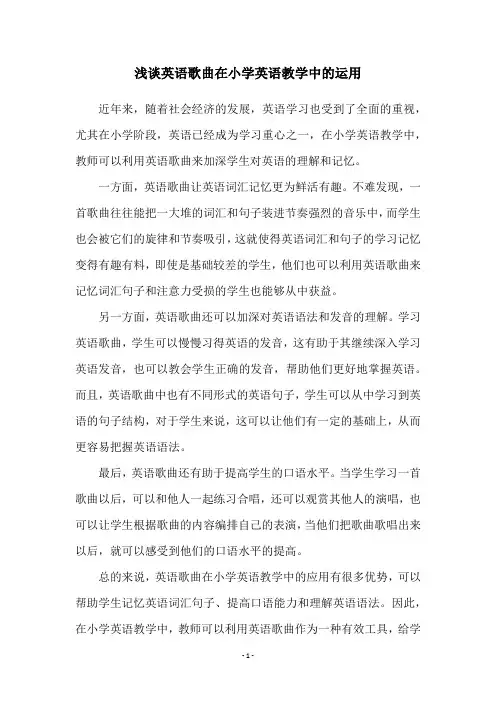
浅谈英语歌曲在小学英语教学中的运用
近年来,随着社会经济的发展,英语学习也受到了全面的重视,尤其在小学阶段,英语已经成为学习重心之一,在小学英语教学中,教师可以利用英语歌曲来加深学生对英语的理解和记忆。
一方面,英语歌曲让英语词汇记忆更为鲜活有趣。
不难发现,一首歌曲往往能把一大堆的词汇和句子装进节奏强烈的音乐中,而学生也会被它们的旋律和节奏吸引,这就使得英语词汇和句子的学习记忆变得有趣有料,即使是基础较差的学生,他们也可以利用英语歌曲来记忆词汇句子和注意力受损的学生也能够从中获益。
另一方面,英语歌曲还可以加深对英语语法和发音的理解。
学习英语歌曲,学生可以慢慢习得英语的发音,这有助于其继续深入学习英语发音,也可以教会学生正确的发音,帮助他们更好地掌握英语。
而且,英语歌曲中也有不同形式的英语句子,学生可以从中学习到英语的句子结构,对于学生来说,这可以让他们有一定的基础上,从而更容易把握英语语法。
最后,英语歌曲还有助于提高学生的口语水平。
当学生学习一首歌曲以后,可以和他人一起练习合唱,还可以观赏其他人的演唱,也可以让学生根据歌曲的内容编排自己的表演,当他们把歌曲歌唱出来以后,就可以感受到他们的口语水平的提高。
总的来说,英语歌曲在小学英语教学中的应用有很多优势,可以帮助学生记忆英语词汇句子、提高口语能力和理解英语语法。
因此,在小学英语教学中,教师可以利用英语歌曲作为一种有效工具,给学
生带来更多的趣味性及启发性,从而激发学生学习英语的兴趣,帮助他们有效掌握英语知识。
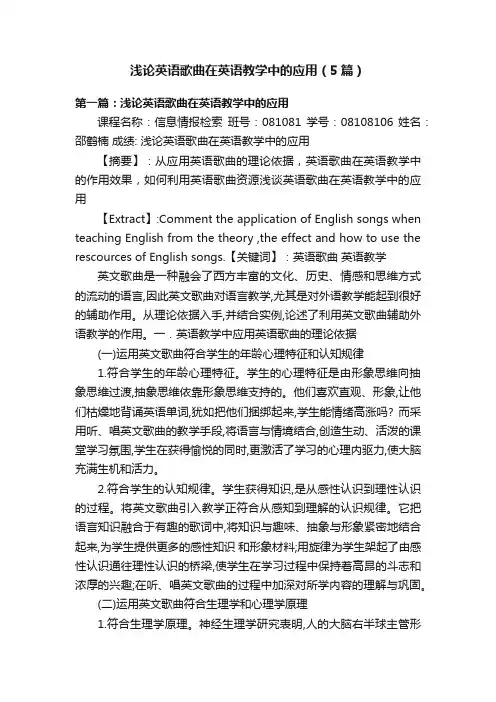
浅论英语歌曲在英语教学中的应用(5篇)第一篇:浅论英语歌曲在英语教学中的应用课程名称:信息情报检索班号:081081 学号:08108106 姓名:邵鹤楠成绩: 浅论英语歌曲在英语教学中的应用【摘要】:从应用英语歌曲的理论依据,英语歌曲在英语教学中的作用效果,如何利用英语歌曲资源浅谈英语歌曲在英语教学中的应用【Extract】:Comment the application of English songs when teaching English from the theory ,the effect and how to use the rescources of English songs.【关键词】:英语歌曲英语教学英文歌曲是一种融会了西方丰富的文化、历史、情感和思维方式的流动的语言,因此英文歌曲对语言教学,尤其是对外语教学能起到很好的辅助作用。
从理论依据入手,并结合实例,论述了利用英文歌曲辅助外语教学的作用。
一.英语教学中应用英语歌曲的理论依据(一)运用英文歌曲符合学生的年龄心理特征和认知规律1.符合学生的年龄心理特征。
学生的心理特征是由形象思维向抽象思维过渡,抽象思维依靠形象思维支持的。
他们喜欢直观、形象,让他们枯燥地背诵英语单词,犹如把他们捆绑起来,学生能情绪高涨吗? 而采用听、唱英文歌曲的教学手段,将语言与情境结合,创造生动、活泼的课堂学习氛围,学生在获得愉悦的同时,更激活了学习的心理内驱力,使大脑充满生机和活力。
2.符合学生的认知规律。
学生获得知识,是从感性认识到理性认识的过程。
将英文歌曲引入教学正符合从感知到理解的认识规律。
它把语言知识融合于有趣的歌词中,将知识与趣味、抽象与形象紧密地结合起来,为学生提供更多的感性知识和形象材料;用旋律为学生架起了由感性认识通往理性认识的桥梁,使学生在学习过程中保持着高昂的斗志和浓厚的兴趣;在听、唱英文歌曲的过程中加深对所学内容的理解与巩固。
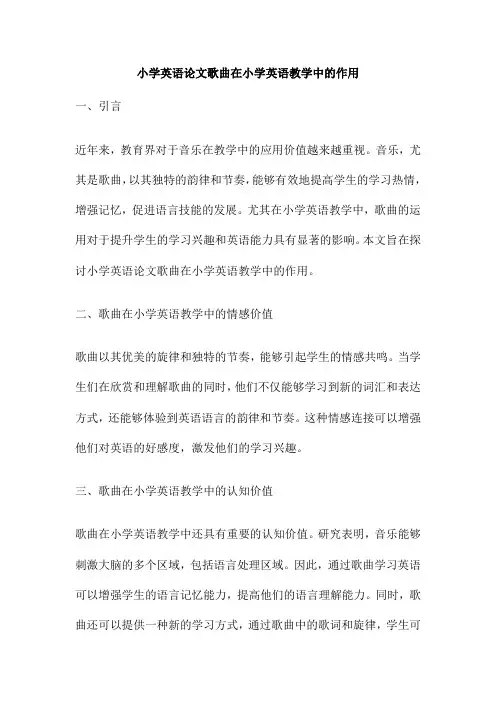
小学英语论文歌曲在小学英语教学中的作用一、引言近年来,教育界对于音乐在教学中的应用价值越来越重视。
音乐,尤其是歌曲,以其独特的韵律和节奏,能够有效地提高学生的学习热情,增强记忆,促进语言技能的发展。
尤其在小学英语教学中,歌曲的运用对于提升学生的学习兴趣和英语能力具有显著的影响。
本文旨在探讨小学英语论文歌曲在小学英语教学中的作用。
二、歌曲在小学英语教学中的情感价值歌曲以其优美的旋律和独特的节奏,能够引起学生的情感共鸣。
当学生们在欣赏和理解歌曲的同时,他们不仅能够学习到新的词汇和表达方式,还能够体验到英语语言的韵律和节奏。
这种情感连接可以增强他们对英语的好感度,激发他们的学习兴趣。
三、歌曲在小学英语教学中的认知价值歌曲在小学英语教学中还具有重要的认知价值。
研究表明,音乐能够刺激大脑的多个区域,包括语言处理区域。
因此,通过歌曲学习英语可以增强学生的语言记忆能力,提高他们的语言理解能力。
同时,歌曲还可以提供一种新的学习方式,通过歌曲中的歌词和旋律,学生可以更好地理解和记忆新的词汇和表达方式。
四、歌曲在小学英语教学中的社会价值歌曲在小学英语教学中还具有重要的社会价值。
通过歌曲,学生可以学习到如何在社交环境中使用英语。
例如,许多英文歌曲都包含了友谊、爱、感恩等主题,这些主题可以帮助学生理解并学习如何在日常生活中使用英语进行交流。
五、结论小学英语论文歌曲在小学英语教学中发挥了重要的作用。
它不仅激发了学生的学习兴趣和热情,还提高了他们的语言记忆能力和理解能力。
歌曲还提供了在社交环境中使用英语的机会,帮助学生更好地掌握英语技能。
因此,教师应该充分认识到歌曲在小学英语教学中的价值,将其有效地融入到教学过程中。
随着全球化的不断深入,英语教育在我国变得越来越重要。
为了激发小学生学习英语的兴趣,提高他们的英语学习效果,英语歌曲在小学英语教学中发挥了重要作用。
本文将探讨英语歌曲在小学英语教学中的运用,旨在分析其意义、作用及具体实施方法。
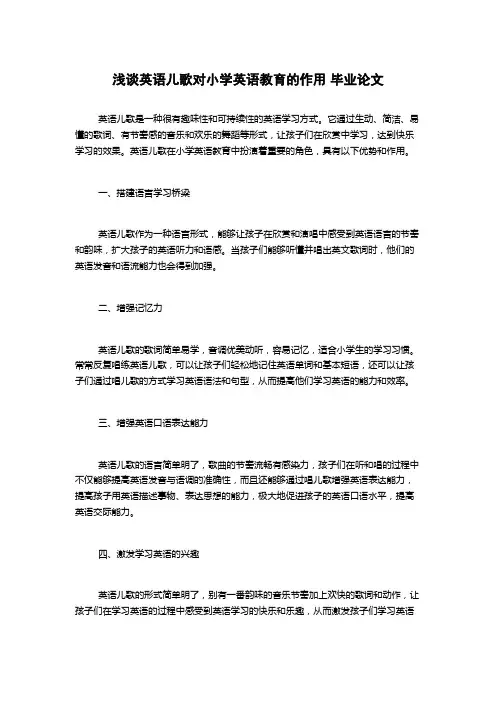
浅谈英语儿歌对小学英语教育的作用毕业论文英语儿歌是一种很有趣味性和可持续性的英语学习方式。
它通过生动、简洁、易懂的歌词、有节奏感的音乐和欢乐的舞蹈等形式,让孩子们在欣赏中学习,达到快乐学习的效果。
英语儿歌在小学英语教育中扮演着重要的角色,具有以下优势和作用。
一、搭建语言学习桥梁英语儿歌作为一种语言形式,能够让孩子在欣赏和演唱中感受到英语语言的节奏和韵味,扩大孩子的英语听力和语感。
当孩子们能够听懂并唱出英文歌词时,他们的英语发音和语流能力也会得到加强。
二、增强记忆力英语儿歌的歌词简单易学,音调优美动听,容易记忆,适合小学生的学习习惯。
常常反复唱练英语儿歌,可以让孩子们轻松地记住英语单词和基本短语,还可以让孩子们通过唱儿歌的方式学习英语语法和句型,从而提高他们学习英语的能力和效率。
三、增强英语口语表达能力英语儿歌的语言简单明了,歌曲的节奏流畅有感染力,孩子们在听和唱的过程中不仅能够提高英语发音与语调的准确性,而且还能够通过唱儿歌增强英语表达能力,提高孩子用英语描述事物、表达思想的能力,极大地促进孩子的英语口语水平,提高英语交际能力。
四、激发学习英语的兴趣英语儿歌的形式简单明了,别有一番韵味的音乐节奏加上欢快的歌词和动作,让孩子们在学习英语的过程中感受到英语学习的快乐和乐趣,从而激发孩子们学习英语的兴趣。
通过唱英语儿歌,孩子们能够体验到学习英语的愉悦,在积极探索中对语言学习产生浓厚的兴趣和热情。
五、培养综合素质英语儿歌不仅增强了孩子们的英语学习能力,也促进了他们身心、智力的全面发展。
在唱儿歌中,孩子们需要边唱边跳舞,进行锻炼身体,同时又要观察、参与、学习,培养了孩子们的观察力、动手能力和团队合作意识,有助于孩子们全面发展。
综上所述,英语儿歌在小学英语教育中具有很大的作用,除了在语言学习方面的效果显著之外,还能够激发孩子们对英语学习的兴趣,提高孩子的综合素质以及身心健康。
因此,应该充分发挥英语儿歌在小学英语教育中的作用,积极鼓励孩子们在学习过程中唱儿歌,让他们在快乐中学习,开启英语学习之路。
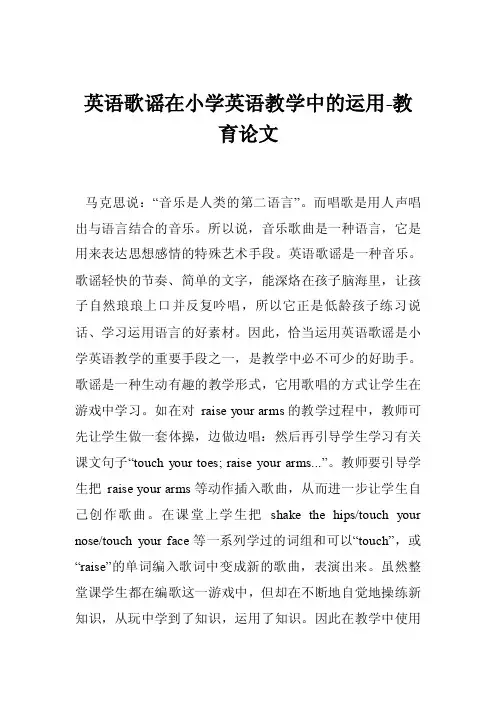
英语歌谣在小学英语教学中的运用-教育论文马克思说:“音乐是人类的第二语言”。
而唱歌是用人声唱出与语言结合的音乐。
所以说,音乐歌曲是一种语言,它是用来表达思想感情的特殊艺术手段。
英语歌谣是一种音乐。
歌谣轻快的节奏、简单的文字,能深烙在孩子脑海里,让孩子自然琅琅上口并反复吟唱,所以它正是低龄孩子练习说话、学习运用语言的好素材。
因此,恰当运用英语歌谣是小学英语教学的重要手段之一,是教学中必不可少的好助手。
歌谣是一种生动有趣的教学形式,它用歌唱的方式让学生在游戏中学习。
如在对raise your arms的教学过程中,教师可先让学生做一套体操,边做边唱:然后再引导学生学习有关课文句子“touch your toes; raise your arms...”。
教师要引导学生把raise your arms等动作插入歌曲,从而进一步让学生自己创作歌曲。
在课堂上学生把shake the hips/touch your nose/touch your face等一系列学过的词组和可以“touch”,或“raise”的单词编入歌词中变成新的歌曲,表演出来。
虽然整堂课学生都在编歌这一游戏中,但却在不断地自觉地操练新知识,从玩中学到了知识,运用了知识。
因此在教学中使用歌谣,只要教师加以引导,学生就会把自己感兴趣的动作、单词编入歌谣。
借助歌谣传授语音、语法与词汇在教学中总有一些令学生困扰的概念,句型,语音,单凭讲又难以理解,歌谣就为此提供了一种解决的方法,就是让学生唱,玩,从中得出区分的方法。
比方语音方面用歌谣“i’m a little snowman”: “i’m a little teapot, short and stout. here is my handle, here is my spout. when th e water’s boiling, hear me shout,‘tip me over, pour me out!’”来操练字母组合“ou”的读音/au/,在这首歌中出现stout,spout,shout,out,它们共同的特点是:有“ou”字母组合,而它们都发/au/音。
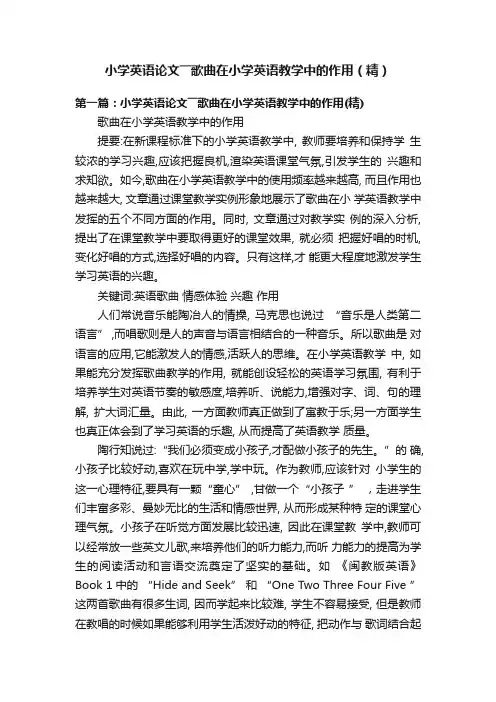
小学英语论文――歌曲在小学英语教学中的作用(精)第一篇:小学英语论文――歌曲在小学英语教学中的作用(精) 歌曲在小学英语教学中的作用提要:在新课程标准下的小学英语教学中, 教师要培养和保持学生较浓的学习兴趣,应该把握良机,渲染英语课堂气氛,引发学生的兴趣和求知欲。
如今,歌曲在小学英语教学中的使用频率越来越高, 而且作用也越来越大, 文章通过课堂教学实例形象地展示了歌曲在小学英语教学中发挥的五个不同方面的作用。
同时, 文章通过对教学实例的深入分析, 提出了在课堂教学中要取得更好的课堂效果, 就必须把握好唱的时机,变化好唱的方式,选择好唱的内容。
只有这样,才能更大程度地激发学生学习英语的兴趣。
关键词:英语歌曲情感体验兴趣作用人们常说音乐能陶冶人的情操, 马克思也说过“音乐是人类第二语言” ,而唱歌则是人的声音与语言相结合的一种音乐。
所以歌曲是对语言的应用,它能激发人的情感,活跃人的思维。
在小学英语教学中, 如果能充分发挥歌曲教学的作用, 就能创设轻松的英语学习氛围, 有利于培养学生对英语节奏的敏感度,培养听、说能力,增强对字、词、句的理解, 扩大词汇量。
由此, 一方面教师真正做到了寓教于乐;另一方面学生也真正体会到了学习英语的乐趣, 从而提高了英语教学质量。
陶行知说过:“我们必须变成小孩子,才配做小孩子的先生。
”的确,小孩子比较好动,喜欢在玩中学,学中玩。
作为教师,应该针对小学生的这一心理特征,要具有一颗“童心” ,甘做一个“小孩子” ,走进学生们丰富多彩、曼妙无比的生活和情感世界, 从而形成某种特定的课堂心理气氛。
小孩子在听觉方面发展比较迅速, 因此在课堂教学中,教师可以经常放一些英文儿歌,来培养他们的听力能力,而听力能力的提高为学生的阅读活动和言语交流奠定了坚实的基础。
如《闽教版英语》Book 1中的“Hide and Seek” 和“One Two Three Four Five ” 这两首歌曲有很多生词, 因而学起来比较难, 学生不容易接受, 但是教师在教唱的时候如果能够利用学生活泼好动的特征, 把动作与歌词结合起来, 学生就能够迅速理解其中词句的含义, 许多疑难点就不攻自破了。
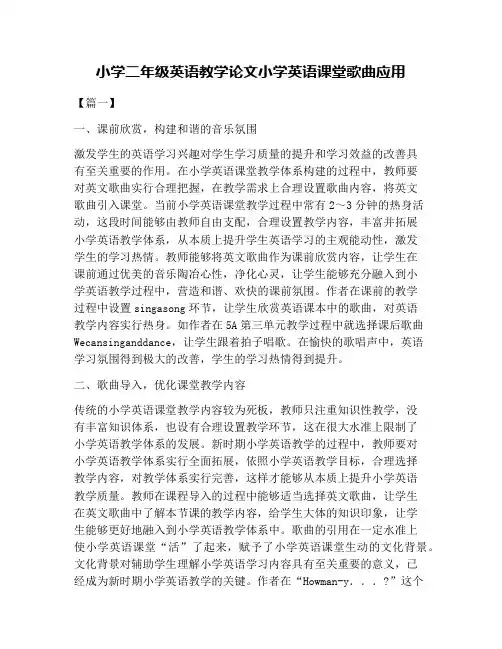
小学二年级英语教学论文小学英语课堂歌曲应用【篇一】一、课前欣赏,构建和谐的音乐氛围激发学生的英语学习兴趣对学生学习质量的提升和学习效益的改善具有至关重要的作用。
在小学英语课堂教学体系构建的过程中,教师要对英文歌曲实行合理把握,在教学需求上合理设置歌曲内容,将英文歌曲引入课堂。
当前小学英语课堂教学过程中常有2~3分钟的热身活动,这段时间能够由教师自由支配,合理设置教学内容,丰富并拓展小学英语教学体系,从本质上提升学生英语学习的主观能动性,激发学生的学习热情。
教师能够将英文歌曲作为课前欣赏内容,让学生在课前通过优美的音乐陶冶心性,净化心灵,让学生能够充分融入到小学英语教学过程中,营造和谐、欢快的课前氛围。
作者在课前的教学过程中设置singasong环节,让学生欣赏英语课本中的歌曲,对英语教学内容实行热身。
如作者在5A第三单元教学过程中就选择课后歌曲Wecansinganddance,让学生跟着拍子唱歌。
在愉快的歌唱声中,英语学习氛围得到极大的改善,学生的学习热情得到提升。
二、歌曲导入,优化课堂教学内容传统的小学英语课堂教学内容较为死板,教师只注重知识性教学,没有丰富知识体系,也设有合理设置教学环节,这在很大水准上限制了小学英语教学体系的发展。
新时期小学英语教学的过程中,教师要对小学英语教学体系实行全面拓展,依照小学英语教学目标,合理选择教学内容,对教学体系实行完善,这样才能够从本质上提升小学英语教学质量。
教师在课程导入的过程中能够适当选择英文歌曲,让学生在英文歌曲中了解本节课的教学内容,给学生大体的知识印象,让学生能够更好地融入到小学英语教学体系中。
歌曲的引用在一定水准上使小学英语课堂“活”了起来,赋予了小学英语课堂生动的文化背景。
文化背景对辅助学生理解小学英语学习内容具有至关重要的意义,已经成为新时期小学英语教学的关键。
作者在“Howman-y...?”这个单元的教学过程中就对教学目标实行了分析,选择Tenlittlecandlesdance这首歌曲作为引入材料,让学生歌唱并表演该歌曲。
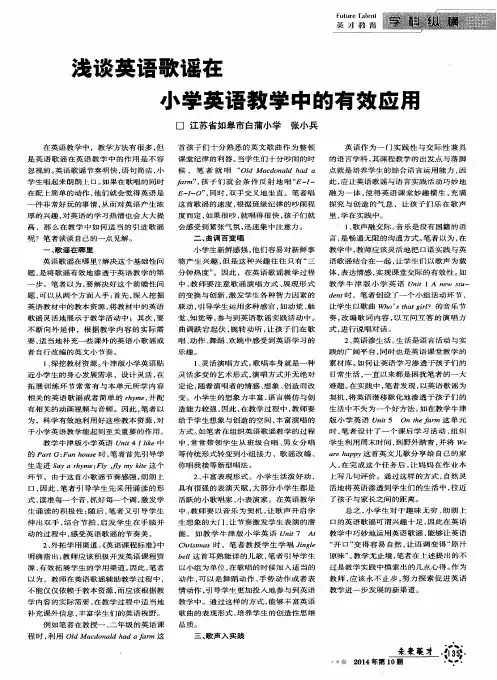
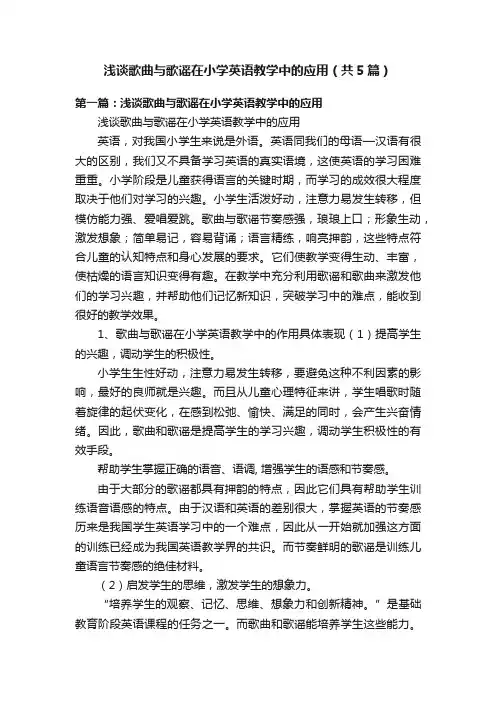
浅谈歌曲与歌谣在小学英语教学中的应用(共5篇)第一篇:浅谈歌曲与歌谣在小学英语教学中的应用浅谈歌曲与歌谣在小学英语教学中的应用英语,对我国小学生来说是外语。
英语同我们的母语—汉语有很大的区别,我们又不具备学习英语的真实语境,这使英语的学习困难重重。
小学阶段是儿童获得语言的关键时期,而学习的成效很大程度取决于他们对学习的兴趣。
小学生活泼好动,注意力易发生转移,但模仿能力强、爱唱爱跳。
歌曲与歌谣节奏感强,琅琅上口;形象生动,激发想象;简单易记,容易背诵;语言精练,响亮押韵,这些特点符合儿童的认知特点和身心发展的要求。
它们使教学变得生动、丰富,使枯燥的语言知识变得有趣。
在教学中充分利用歌谣和歌曲来激发他们的学习兴趣,并帮助他们记忆新知识,突破学习中的难点,能收到很好的教学效果。
1、歌曲与歌谣在小学英语教学中的作用具体表现(1)提高学生的兴趣,调动学生的积极性。
小学生生性好动,注意力易发生转移,要避免这种不利因素的影响,最好的良师就是兴趣。
而且从儿童心理特征来讲,学生唱歌时随着旋律的起伏变化,在感到松弛、愉快、满足的同时,会产生兴奋情绪。
因此,歌曲和歌谣是提高学生的学习兴趣,调动学生积极性的有效手段。
帮助学生掌握正确的语音、语调, 增强学生的语感和节奏感。
由于大部分的歌谣都具有押韵的特点,因此它们具有帮助学生训练语音语感的特点。
由于汉语和英语的差别很大,掌握英语的节奏感历来是我国学生英语学习中的一个难点,因此从一开始就加强这方面的训练已经成为我国英语教学界的共识。
而节奏鲜明的歌谣是训练儿童语言节奏感的绝佳材料。
(2)启发学生的思维,激发学生的想象力。
“培养学生的观察、记忆、思维、想象力和创新精神。
”是基础教育阶段英语课程的任务之一。
而歌曲和歌谣能培养学生这些能力。
例如:在教学At a Music lesson时,当学生会唱了课本上的“We can sing and dance”这首歌时,就应鼓励他们根据这首诗进行自由改编,学生的思维一下活跃起来,小学生的想象力很丰富,往往他们的改变成果都很好。
儿歌和歌谣在小学英语教育中的应用对于孩子来说,学好英语的关键之一是提高孩子们英语学习的兴趣。
想要让孩子对英语感兴趣,最普遍、最有效的方式就是在教学中引入歌曲或歌谣,在这个过程中吸引孩子的注意力,提高他们的学习兴趣,让他们积极参与到学习中来。
在教学中教师利用富有特色的英语歌谣或儿童来教学,带给孩子们一个活泼愉快、宽松和谐的语言氛围,这可以使我们的教学收到更佳的效果。
虽然教师不能把歌谣当作教学的惟一重点,但是我们不能否认,“在儿童英语教学中,儿歌和童谣起着不可或缺的作用”。
一、英语儿歌的特点及种类英语儿歌的主要特点1.语言浅显。
英语儿歌中使用的词汇主要是名词(动物、植物、食物、日常用品、交通工具等)、动词(走、跑、跳、爬等基本动作)、形容词(颜色、形状、大小等),这些词反映的事物及其属性比较具体,契合了儿童的思维特点。
同时,英语儿歌中简单句的大量使用,容易为他们所接受和掌握。
2.形象具体可感。
英语儿歌作品的语言着力于突出人和事物的形态感、色彩感和动作感。
使儿童念起来感到如临其境、如见其人、如闻其声、如触其物。
英语儿歌中的摹声和拟人表现手法的运用,增强了儿歌的形象性。
摹声:摹声能引起幼儿的听觉直感,唤起他对事物的注意、想象和理解。
例如儿歌《Animals》:“Cat,cat,cat,mlao-miao-miao.Dog,dog,dog,wang-wang-wang.”儿歌中的“miao”、“wang”等词的运用使孩子们产生身临其境的感觉,激发学习的情绪。
拟人:拟人是儿童英语文学中使用最多、深受喜爱的表现手法。
例如儿歌:老虎tiger穿花袍,尾巴tail摇一摇,百兽之中它称王,fox见到赶快逃。
3.音韵自然和谐。
儿歌中特有的悦耳和谐的音韵和鲜明的节奏能使学生产生愉悦感。
例如儿歌:“Nodyourhead,Yes,yes,yes.Shakeyourhead,No,no,no.Raiseyourhand,Onetwothree.Putyourheaddown!Lookatme!”音节自然响亮,易学易记,同时配合节奏边念儿歌边做动作,带给作品内在的乐感。
英语歌曲在小学英语教学中的应用【摘要】英语歌曲在小学英语教学中的应用具有重要意义。
通过英语歌曲可以提高学生学习兴趣,激发他们学习英语的热情。
英语歌曲可以帮助学生记忆词汇和句型,使学习更加生动和有效。
学生通过唱歌还能培养语感和语调,提升自己的语言感知能力。
英语歌曲还可以促进学生的听力和口语能力的发展,使他们在实际交流中更加流利。
通过唱歌,学生还会增加与外国文化交流的机会,扩展自己的视野和认知。
未来,英语歌曲在小学英语教学中将继续发挥积极作用,促进学生英语能力的全面提升。
英语歌曲在小学英语教学中的应用是不可或缺的,可以为学生的语言学习带来更多的乐趣和成果。
【关键词】英语歌曲, 小学教学, 应用, 学习兴趣, 记忆词汇, 句型, 语感, 语调, 听力, 口语, 文化交流, 重要性, 展望, 总结.1. 引言1.1 英语歌曲在小学英语教学中的应用英语歌曲在小学英语教学中扮演着重要的角色,它不仅能够激发学生学习的兴趣,提高他们的学习动力,还可以帮助他们更好地记忆词汇和句型,培养语感和语调,促进听力和口语能力的发展,增加文化交流的机会。
通过欣赏和学唱英语歌曲,学生不仅能够感受到不同语言和文化的魅力,还能够在轻松愉快的氛围中提升自己的英语水平。
英语歌曲的旋律使学习过程更加生动活泼,让学生在学习中享受音乐的愉悦,激发学习兴趣。
在小学英语教学中,教师应该充分利用英语歌曲这一教学资源,创造出更加丰富多彩的教学方式,帮助学生更好地掌握英语知识,提高他们的语言表达能力和交流能力。
英语歌曲在小学英语教学中具有重要的意义,对学生的英语学习起着不可或缺的作用。
2. 正文2.1 提高学生学习兴趣One of the key benefits of using English songs in primary English teaching is that it can greatly enhance students' interest in learning. Music has a unique way of capturing students' attention and engaging them in the learning process. When students are exposed to catchy tunes and meaningful lyrics, they are more likely to be motivated to participate actively in the lesson.2.2 帮助记忆词汇和句型英语歌曲在小学英语教学中不仅可以提高学生学习兴趣,还可以帮助他们记忆词汇和句型。
(歌曲歌谣助力小学英语课堂)引言:在小学英语教学中,教师需要寻找有效的教学方法,激发学生对英语的兴趣和积极性。
歌曲歌谣是一种具有趣味性和生动性的教学手段,可以让学生在愉快的氛围中学习和掌握英语知识。
本文旨在探讨歌曲歌谣在小学英语课堂中的应用及其优势,并提供实践方法和建议。
一、歌曲歌谣在小学英语课堂中的应用优势1.增强学习兴趣:歌曲歌谣的旋律和节奏可以吸引学生的注意力,让他们更加积极主动地参与课堂活动。
这种教学方式可以激发学生的学习热情,提高他们对英语的兴趣。
2.培养语感:歌曲歌谣中的韵律和节奏有助于培养学生的语感,让他们在不知不觉中掌握英语的发音和语调。
这种语感的培养对于提高学生的英语口语表达能力具有重要意义。
3.增强记忆:歌曲歌谣的歌词通常富有韵律和重复性,这有助于学生记忆单词、短语和句型。
通过反复吟唱,学生可以在轻松愉快的氛围中加深对英语知识的印象,从而提高记忆效果。
4.促进语言交流:歌曲歌谣的歌词通常与日常生活相关,这有助于学生在实际生活中运用所学英语知识进行交流。
通过歌曲歌谣的练习,学生可以逐渐克服语言障碍,提高英语口语表达能力。
二、实践方法1.选择适合的歌曲歌谣:教师在选择歌曲歌谣时,应考虑学生的年龄特点和英语水平,选择旋律优美、歌词简单易懂的曲目。
同时,教师应关注歌曲歌谣的文化背景,确保所选内容符合教学要求和学生实际。
2.合理安排教学时间:教师在课堂上应合理安排歌曲歌谣的教学时间,确保学生有足够的时间学习和练习。
教师可以在课前或课中适当穿插歌曲歌谣的欣赏和表演,以激发学生的学习兴趣和参与度。
3.组织多样化的教学活动:为了提高学生的学习兴趣和参与度,教师可以组织多样化的教学活动,如小组合作表演、歌曲比赛等。
这些活动可以帮助学生更好地理解和掌握歌曲歌谣的内容,同时也有助于培养学生的合作精神和竞争意识。
4.注重歌曲歌谣的延伸:除了课堂教学,教师还可以鼓励学生将所学歌曲歌谣延伸到日常生活中。
谈英语歌曲歌谣在小学英语教学中的合理运用摘要]英语歌曲歌谣具有旋律优美、节奏鲜明、朗朗上口、通俗易学等优点,把歌曲歌谣引入小学英语教学中早已不是什么新鲜事,但是如何在小学英语教学中灵活、合理地运用,使其更好地服务于教学,却是一个永恒的话题。
本文结合教学实例,详细论述了英语歌曲歌谣在小学英语教学中的合理运用。
[关键词] 小学英语英语歌曲歌谣合理运用优化课堂英语作为一门语言学科,单调的听说读写训练是必要的,但对于活泼好动,爱唱爱跳的小学生来说,难免显得乏味枯燥,学习积极性势必受到影响。
巧妙地将歌曲歌谣和小学英语教学有效结合,不仅可以激发学生的学习热情,活跃英语的课堂氛围,而且能加深学生对英语字、词、句等理解和运用,使教学达到事半功倍的效果。
歌曲歌谣具有旋律优美,语言浅显,内容生动,节奏明快、韵律响亮等特点。
它能让学生通过聆听、唱诵的形式,将所学内容易于理解和巩固;它能将学生的学习兴趣充分激发出来,并将学习动力不断得以保持;它能让学生的语感和语言素养带来很大的帮助和提高。
(一)囊括新授内容,化解难点奔主题英语教学中的导入是展开教学最为关键的一步。
导入的效果直接关系到学生的学习积极性。
歌曲歌谣导入是教师常用的方式之一,这样的导入除了能有效调动课堂气氛外,还能温故知新,有效化解教学难点。
例如,在教学PEP五年级上册的方位词这一单元,学生对方位的理解难度较大。
in,on , under 是旧知,这个单元又增加了behind , in front of ,next to, between,over等较难新词汇。
教师可采用歌曲 Wher e’s the monkey? 直观引导学生学习。
(二) 饱含语音要素,渗透规则利拼读英语要说好,发音和节奏上关键。
歌谣的节奏明快,合辙押韵正是训练学生语感语流的绝佳途径。
在反复的吟唱诵读中自然地建立起字母和发音的联系,长此训练,便能很快提升“见词能读,听音能写”的能力。
例如在低段的语音教学中,把较难的/e/和/ ? /含有相同音素的单词编成歌曲或歌谣,不仅巩固了语音知识,而且加深了学生对某音素的记忆。
课题论文:使用英语歌谣,促进小学英语教学马克思说:“音乐是人类的第二语言”。
而唱歌是用人声唱出与语言结合的音乐。
所以说,音乐歌曲是一种语言,它是用来表达思想感情的特殊艺术手段。
英语歌谣是一种音乐。
歌谣轻快的节奏、简单的文字,能深烙在孩子脑海里,让孩子自然琅琅上口并反复吟唱,所以它正是低龄孩子练习说话、学习运用语言的好素材。
一、歌谣教学的作用。
1、英语歌谣能唤起儿童学英语的热情。
兴趣是最好的老师。
英语歌谣节奏明快,语句简洁,小孩唱起来琅琅上口。
如果小孩在歌唱时再配上简单的动作,他们就会又唱又跳,觉得学英语是一件好玩的事情,从而对英语产生浓厚的兴趣,学英语的热情也就大大提高。
歌谣中含有描述景象、塑造人物,以及表现情节,它常是一些幽默的故事,可为小孩带来无限的快乐,Old MacDonald Had a Farm;This Little Pig Went to Market;Star Light,Star Brigh t.等儿歌都蕴含生动情节,迷人景象。
学生在欢唱的同时也似乎在听动人的故事。
这样,小孩就会觉得学英语生动有趣,并不是一件枯燥乏味的事情。
2、英语歌谣能增进小孩英语语感,使其能以优美、流利的语调说出自然的英语。
学习一种英语,或多或少受到自己母语的影响或干扰,中国人学习英语,由于英语的发音部份与汉语不同,常常会碰到一些发音上的问题,如重音(stress)、节奏(rhythm)、连音(linking)、语调(intonation),而英语儿歌的唱诵对正确语音能力养成了重要作用。
英语语调的曲折升降犹如音乐曲调的委婉起伏,英语语音中的重读与轻读又象乐曲的轻拍与弱拍。
现代课程改革另一项内容就是要求教学内容接近学生生活,而英语歌谣通常取材于儿童日常生活的点滴,都是以儿童的自然语言写成。
应用歌谣教学与课程改革要求不谋而合。
3、英语歌谣能增进小孩对英美文化的了解。
语言依存于文化,不能脱离文化而单独存在,语言在学习也不能单是分析语法、记忆单字、朗诵课本,还需了解当地人民的生活习俗、社会价值和种种禁忌,这样的学习才能可持续进步。
The Application of English Songs andBallads to Primary English Teaching inChina1. INTRODUCTIONAt present, most of Primary English teachers are using cramming teaching method to teach English. However, under the situation of cultivating the quality-oriented education, traditional cramming teaching method can’t meet students’needs. That is because the personalities of the pupils are very different from those of middle school students. They are naughty, lively and active, paying less attention on teachers . Therefore, it is very important to discuss how to make pupils be fully involved in the English class and be interested in English learning.Basing on The Theory of Multiple Intelligence, Situational Teaching Methodology and the characteristics of elementary school students, this paper aims to find an effective way to teach English so as to strengthen students' learning interests and stimulate their curiosity for knowledge with the help of the English songs and ballads. I will also focus on illustrating the example of how to design and use English songs and ballads in Primary English teaching and aim to give some suggestions to the Primary English teachers so that they can achieve fruitful teaching.2. LITERATURE REVIEWTo promote the effectiveness of students’English learning , many experts tried their best to find some solutions to make pupils fully involved in English class and be interested in learning English. Among them, the researches about the theory of multiple intelligence and situational teaching methodology are the best representatives.2.1. The Theory of Multiple IntelligenceThe Theory of Multiple Intelligence was put forward by Howard Gardner, a psychological development specialist of America in 1983. Dr. Howard Gardner (1983) pointed that human intelligence is diverse rather than single, which is mainly made up of linguistic intelligence, logical-mathematical intelligence, spatial intelligence, body-kinesthetic intelligence, musical intelligence, interpersonal intelligence, self-awareness intelligence and naturalist intelligence. Everyone has a different combination of intelligent advantages. That is to say, teachers should develop students’multiple intelligence to help pupils to fulfill comprehensive development.At the same time, the theory believes that teachers should learn to cooperate with pupils and use the cooperative teaching methodology which helps pupils to be fully involved in the English class, trains their learning interests and stimulates their curiosities for knowledge . Further to say, making pupils be fully involved in the English class is the basis of organizing class teaching, including rich and colorful teaching activities which can help pupils to develop multiple intelligence and fulfill comprehensive development. Thus, here comes the question: what can teachers do in order to help pupils develop their multiple intelligences?The answer to this question is putting the concept of multiple intelligence into English courses to develop multiple intelligence curriculum modes and teaching plans which is the best starting point that using the theory of multiple intelligence in English teaching practice.2.2. Situational Teaching MethodologyThe Situational Teaching Method was established and prevailed in England from 1930s to 1960s. In the 1970s, it was introduced to China and well-known in the foreign language field. It is a way that teachers create some vivid projection drawings according to the passages, supplemented with vivid literary language to reproduce some scenepresentations of the texts with the help of music which can make the students have the feelings of being personally on the scene. English Situational Teaching Methodology is based on the basic theory of situational teaching and achieve communication goals by creating situations and atmospheres of English learning. English Situational Teaching Methodology believes that teachers make full use of the images , creating the vivid situations, making the abstract form of language become vivid according to students' age characteristics and psychological characteristics and follow the law of reflection of cognition combined with the teaching content to create English language environment as much as possible and let the student come into contact with more English language and dominant behavioral ways in English. Then, why we use English Situational Teaching Methodology in English teaching, particularly in Primary English teaching?There are three theoretical foundations of using English Situational Teaching Methodology in Primary English teaching. On the first hand, it corresponds to students’age characteristics and psychological characteristics. Students, especially Primary School students have a strong desire for learning English knowledge. On the second hand, English Situational Teaching Methodology does good in cultivating students’emotions , enlightening their thinking abilities and developing their intelligences. The most important thing is that it is good for making classroom atmosphere active and vivid. On the third hand, English Situational Teaching Methodology can mobilize students' mental activities consciously, making students study English in a relaxing , happy and positive atmosphere. So far, we can draw a conclusion that using English Situational Teaching Methodology is an effective way in teaching. Therefore, to make Primary English teaching more effective, we may try to use English Situational Teaching Methodology in Primary English teaching.2.3. The Current Research SituationIn China, under the situation of the quality-oriented education and curriculum revolution , Primary English teachers are trying their best to find some effective ways tomake their classes interesting , active and vivid. Meanwhile, some teaching experts also do their best to find some solutions that can help Primary English teachers teach well in Primary English teaching. Lai Junping (2001) mentioned that students could benefit from using English songs in Primary English teaching in her thesis. Wang Qiang (2003) wrote a book called Teaching English in the Primary School from Theory to Practice..In her book , she has showed us that songs and rhymes are good for motivating children in learning .Ma Jingjing( 2010) has done a research which focused on how to use English songs in English teaching in the Primary School.Although, those experts have done a lot of researches about whether using English songs and ballads in Primary English teaching is an effective way to make English classes worthwhile or not, each expert gave some one-sided ideas. Namely they can’t give comprehensive interpretations about the reasons, the functions and the strategies of using English songs and ballads in Primary English teaching. The key point is that most of them seldom show a vivid example illustration of using original English ballads to us and do some investigations to students who they teaches about whether they are interested in the class. This paper will mainly focus on showing a vivid example illustration of using original English ballads to readers and some useful measures to improve the situation will be put forward according to the result of investigations to my students in Grade 5 of YuXi No.1 Primary School.3. THE NECESSITIES AND FUNCTIONS TO APPLY ENGLISH SONGS AND BALLADS IN PRIMARY ENGLISH TEACHING3.1. The Requirements of Primary English Curriculum StandardThe new Primary English Curriculum Standard was promulgated by Ministry of Education in 2010. It pointed out Studying is not the outer control, but an innerembodiment. Studying process should be started from the pupil’s interest, life experience and the cognitive level. The pupils’ability in using language should be developed. Therefore, the Primary English teaching which is under the idea of the Primary English New Curriculum Standard should be improved, then much emphasis should be placed on how to make students be the center of the classroom, and how to make the class more active.The Primary English New Curriculum Standard also suggested that the total goal of Primary English courses is to cultivate the abilities of students' comprehensive language application, and Primary English curriculum objectives are divided into two levels in the preliminary stage. At the first level, the Primary students are required to learn English from Grade 3. By the end of Grade 4, students are required to be able to sing 15 to 20 English songs and ballads or simple English poetries. At the second level, students are required to be able to sing 30 to 40 English songs and ballads by the end of Grade 6.3.2. Characteristics of Primary School StudentsThere is a saying that interest is the best teacher. R.Gardner and mbert find that the successful learners are those people who have both genius and great learning motivation in the second language studies. (Corder.S.P.1985) It seems to the English learners, especially young English learners, nothing but what they are really interested in can make them produce motivation and desire for studying English.That is because pupils who are at the age of 8-13 have strong curiosities about anything that they come into contact with. Generally speaking, pupils who are between 8 and 13 have less psychological burden, being filled with spirit of innovation and being eager to show themselves to others. They have strong desire to show off and want to be appreciated or praised. Therefore, pupils will think it is interesting and new that teacher teaches them to sing English songs and ballads in Primary English classes. Meanwhile, pupils not only have a strongly imitative ability and a good memory, but also have astrong thirst for knowledge. Nevertheless, pupils are active and lively, even paying less attention on teachers and doing anything that they want to do during classes, sometimes they break class discipline so that it is very difficult for teachers to seize pupils’attention. Because they don’t like mechanically memorizing anything. Therefore, using English songs and ballads in Primary English teaching accords with the nature of the children and can help stimulate their learning interest.3.3. The Functions of Using English Songs and Ballads in Primary English Teaching3.3.1. To Improve Students’ InterestsAs we all know that Primary School students usually like singing and pay more attention to playing. However, the main purpose of Primary English teaching is to cultivate students' interest in language learning. Applying English songs and ballads in Primary English teaching is one of the simplest and the most direct teaching methods. It gets rid of the idea of ‘teacher-center’or ‘textbook-center’in traditional Primary English teaching. It can help to improve class atmosphere and achieve active learning. At the same time, pupils can get a kind of achievement from English songs and ballads. Finally, they are interested in learning English.3.3.2. To Strengthen Cultural Knowledge of StudentsWhen the pupils appreciate English songs of different styles, they will have a lot of wonders about them. At the moment the teachers may show something about different culture, geography, history, ect. It is very necessary for pupils to understand foreign cultural knowledge, which may satisfy students’ natural curiosity about everything new besides strengthening their cultural knowledge. For example, when Christmas Day is coming, the teacher may teach some Christmas songs, like Jingle Bells , Silent night, Santa Claus is coming to Town, then tell the students some popular legend about Santa Claus and how the western people celebrate Christmas Day.3.3.3. To Improve Teacher-student RelationshipEnglish teachers may collect some relative materials which pupils are keen on according to pupils’ interests and hobbies, or motivate pupils to collect something that they are favorable to. Then teachers and students may share their materials and ideas each other , thus can create a harmonious atmosphere between teachers and students. It can also help to narrow the distance between them and make classroom atmosphere more active.Harmonious relationship is good for relieving pupils’ pressure in mind and make them relaxed. It does good to increasing the pupils’ enthusiasm and making them take part in class activities actively. It is also good for increasing the pupils’desire to participate in learning and producing fruitful teaching products.3.3.4. To Improve Students’ Language SkillsAt the beginning of leaning English, primary students may have many difficulties in learning English. Because they have no real English language environment, it is very difficult for pupils to memorize the words, understand the meaning of the sentences and master grammars rules. If teachers teach pupils in traditional teaching methods that require pupils to memorize new words and new structures mechanically, the result is that most of the pupils will lose interest in learning English and be afraid of having English classes so that they won’t learn English well. As we all know that English is constituted by vocabulary, some words are difficult to memorize and can be forgotten easily.When we try our best to help pupils memorize English words in the process of singing English songs and ballads, they will recite them easily. That is to say, applying English songs and ballads to teaching pupils creatively, we will help pupils ease their burden naturally.English songs and ballads may help pupils in listening. Listening tasks are also important in Primary English teaching. English songs and ballads are good materials for pupils to practise listening. Using English songs and ballads are an alternative to the traditional listening comprehension. At the same time, English songs and ballads caneven help pupils correct pronunciation and intonation.We have all noticed that children learn things better when learning is taking place indirectly. When children are singing English songs and ballads, they may be normally aware that they are enjoyable and having fun. Pupils may learn to sing English songs and ballads after tape recorder or their teacher naturally, thus there will be a great improvement in their pronunciation and intonation.In total, English Songs and ballads can help children with memorizing the new vocabulary, mastering the new structures, improving their listening comprehension ability and correcting their pronunciation and intonation.4. THE STRATEGIES OF USING ENGLISH SONGS AND BALLADS TO TEACHING ENGLISH IN PRIMARY SCHOOLIt is very necessary to put theories into practice for Primary English teachers. Primary English teachers may try to use English songs and ballads in Primary English teaching. Nevertheless, as an old saying: Look before you leap. It means that teachers should prepare very well . We not only have to use English songs in the textbooks, but also have to learn to create English ballads by ourselves.There are many English songs in PEP Primary English books. Therefore, Primary English teachers could try to make full use of them. I have been a trainee English teacher in No.1 Primary School of YuXi City for three months. In the beginning, when I taught them in traditional teaching method , I found that they didn’t seem to be interested in my teaching. They felt very tired and boring , doing whatever they wanted to do in the class. After class, I reflected on myself and did a lot of researches about some relevant teaching theories and teaching methodologies, I tried to use English songs in the textbook and created English ballads according to new expressions and structures in the textbook. After a period of time, I found that most of students could beinvolved in my class even though some of them were not interested in English class before. Next, I will share my ideas about how to teach Primary English with the help of English songs and ballads and give some suggestions to Primary English teachers4.1. Using English Songs in the TextbookIn PEP Primary English book 5, unit 2, there is an English song named My Days of the Week. (The key words were in bold face type)My Days of the WeekMonday Tuesday , Wednesday Thursday Friday.Days for school, Days for School.Saturday and Sunday, Days for fun.Happy time, fun time, for everyone.”4.1.1. Playing and Appreciating English SongsFor the purpose of setting a certain mood and relaxing my students, I broadcasted the English song once at the beginning of the class. Meanwhile, I wanted to draw back their attention from what they have done during playtime and to let the students know they were entering a different environment. During those first few minutes, I spoke to the students individually as usual. Then, I broadcasted the song once again and asked my students to listen to it carefully. After finishing listening to the song, I invited some of my students to share the main content of the English song and key words that they captured from the English song with us according to their understanding. Thus, I used the English song as a smooth lead-in naturally. And, it also helped my students to practise their listening skills unconsciously.4.1.2. Teaching Key Words and LyricTo make the students understand the English song better , I firstly gave them the main idea of the English song. Then , I led them to circle key words , included in the lyric , and read the key words and lyric several times. Just remember that when we tell the students the main meaning of the song, we had better not translate it sentence by sentence and analyse grammars which are included in the song.4.1.3. Singing the English SongStudents are required to sing the English song sentence by sentence following the sound recorder or teacher teaches students to sing the English song several times until the students could sing the English song by themselves. But, we must bear it in mind that the teacher must prepare it very well before the class. If not, the class will be out of control. When I taught my students My Days of the Week, I didn’t prepare it very well before the class. Therefore, I sung the song out of tune. The students laughed at me all the time and the class was out of order.4.1.4. Encouraging Students to Make Performance.To make students master the song well, the teacher can organize the students to perform in groups. After the students could sing the song fluently, I organized them to sing the song in groups. I divided all the class into four groups and held an English Songs Contest. Competitions among groups were good for promoting the enthusiasm of the students. They took part in the activities actively so that they could get an honor for their groups. It was conceivable that the classroom atmosphere was very active. 4.1.5. Evaluation and FeedbackEvaluation is a very important part of English teaching. Appreciation and encouragement have an extraordinary significance and function for students, especially for pupils who are willing to be praised extremely. When I had my class, I used to say with smile: ‘Don’t be nervous.’‘Try again.’‘Take it easy.’‘Never mind.’When the pupils had a good performance , I said ‘Excellent.’‘You did a good job.’‘Well done.’‘You look sharp.’and so on. In that way, the pupils’tension will be eased, their confidence will be increased. It is worthy of being mentioned that it is necessary for teachers to give pupils some awards. Even though it is a sticker, pupils want to get it very much. It was my great honor that I was chosen to be an advisor of pupil’s English Community of YuXi No.1 Primary School.. The members were those who came from different classes in Grade 5. As far as I was concerned that it was a good opportunity for me to check what they have learned during the class. So, I organized them to hold anEnglish Songs Party, students from different classes could show their singing. Then, I awarded those pupils who were excellent and an honorary certificate to the most excellent class. From then on, they were very interested in my class and they tried their best to take part in the activities . To draw an conclusion that it is very necessary for teachers to give them evaluations and feedbacks immediately according to what pupils have done. It can enhance pupils’ confidence in speaking English.4.2. Using English Ballads Created by TeachersAs an result of applying English songs in the textbook to Primary English teaching, most of my students were interested in my class. Therefore, I tried to create English ballads by myself to teach Primary English . As far as I am concerned, the most important thing is that the English ballads created by teachers can be be more suitable for the students.4.2.1. Creating English Ballads in Accordance with Practical TeachingTo create one or more excellent and useful English ballads, it is vital for teachers to analyse the materials and contents well. At the same time , it is very necessary to follow some principles during collecting materials so that we can create some good English ballads. For one thing, materials that we are going to collect should be very easy and the music should be very wonderful so that pupils can understand them easily . For another thing, the lyrics that we collect which should be equal to students’ cognitive level. When we create ballads, teachers should consider learners' learning motivation, and learning attitude. In PEP Primary English book 5, unit 4, the topic is What Can You Do ? . When I taught my students new expressions in that unit. I firstly tried my best to analyse the text. That unit mainly focus on the expressions about what somebody can do. So, I tried to collect some useful expressions and some fashionable music that were fit for the theme , then on the basis of pupils’ cognitive level and text understanding. I created the ballad as following: (The key words were in bold face type)The happy songTeacher: If you are happy and you know it,Students: Sweep the floor.Teacher:If you are happy and you know it,Students: Sweep the floor.Teacher: If you are happy and you know it and you really want to show it , Together: If you are happy and you know it, and you really want to show it , sweep the floor.Teacher: If you are happy and you know it,Students: Cook the meals.Teacher: If you are happy and you know it,Students: Cook the meals.Teacher: If you are happy and you know it and you really want to show it , Together: If you are happy and you know it, and you really want to show it, cook the meals.Teacher: If you are happy and you know it,Students: Clean the bedroom.Teacher: If you are happy and you know it,Students: Clean the bedroom.Teacher: If you are happy and you know it and you really want to show it , Together: If you are happy and you know it, and you really want to show it, clean the bedroom.Teacher: If you are happy and you know it,Students: Water the flowers.Teacher: If you are happy and you know it,Students: Water the flowers.Teacher: If you are happy and you know it and you really want to show it ,Together: If you are happy and you know it, and you really want to shoe it, water the flowers.Teacher: If you are happy and you know it,Students: Empty the trash.Teacher: If you are happy and you know it,Students: Empty the trash.Teacher: If you are happy and you know it and you really want to show it , Together: If you are happy and you know it, and you really want to show it, empty the trash.4.2.2. Teaching Ballad by Showing Pictures and Doing RoleplayThe main purpose of creating English ballads is to make English class vivid and active. According to Situational Teaching Methodology and the Theory of Multiple Intelligence, I designed a lot of activities to make my class interesting and made all activities seem like games, not exercises. The teaching objective in unit 4, book 5 is to let students master these five expressions: sweep the floor, cook the meals, clean the bedroom, water the flowers, empty the trash. Therefore, the most important thing was that the English ballad which I created was to teach students new expressions in the forth unit. Therefore, I firstly used pictures to show these English expressions which are related to housework. Then, I designed some class activities to strengthen students’words-memorizing. I took five objects: broom, pan, flowers, watering can, dustbin to the class so that we could use them to play the game named ‘Let’s do together’. We spoke out the expressions and did actions which accorded to the expressions. Because almost each student was interested in the objects that I took to the class. I invited some of students to go to the front of the class and do actions and I ordered the rest of the class to do actions following with the student in the front of the class and spoke out the expressions loudly . The students were very active and the class atmosphere war very harmonious.After finishing teaching them new words, I led them to practise those fiveexpressions with the help of the English ballad which I created. As the lyric was a little difficult for students in Grade 5, I sung the song twice while the students only listened to me. They not only began to understand and to absorb the tune and the rhythm or hum the tune, but also practised their skills of listening comprehension. The key points of that English ballads was those five expressions. Therefore, I asked some of my students to tell me the key words and the main idea of this English ballads after listening to the English ballad. Then we did role playing games according to the lyric above. I ordered my students to shake their bodies after me following with the rhythm. They might think it amusing to behave like small children especially when I was performing along with the group. They were very exciting so that they looked forward to preparing a performance in front of the class in turns . Then , I organized pupils to practise the ballad in group 4. At last, I checked, inviting them to make a performance in front of the class in turns. Because of pupils’ competitive psychology, they were very active.By asking students to sing the ballad along with doing actions, students combined the abstract English words with daily housework so that they experienced the enjoyment and applicability of learning English in the process of making performance and singing the ballad.There was another example, once I helped another English teacher to have class of grade one at YuXi No.1 Primary School. I planned to teach pupils four new words about animals. Before the class, I prepared four animals pictures and created a very easy ballad. That is :Group one: Pig pig, it is a pig.Pig pig, lu lu lu.Group two: Cat cat, it is a cat.Cat cat, mew mew mew.Group three: Dog dog, it is a dog.Dog dog, wang wang wang.Group four: Cow cow,, it is a cowCow cow, meng meng mengDuring the class, I taught them how to read four words with the help of pictures firstly. Then, we played the game named ‘little train’to practise reading those four words. They liked that game very much. For those excellent students, I gave them stickers as awards. Then, I began to teach them the English ballad that I created to further practise those four words. I taught them to read the ballad and do actions. Finally, students were divided into 4 groups to do the role-playing and compete for top one.These words were a little difficult for students in Grade one, but when they made performance vividly, they remembered them quickly and easily.4.3. My Reflection and Suggestion of Using English Songs and Ballads in Teaching English in the Primary SchoolAfter the classes, I had some reflections according to students' performances . Firstly, I must admit that using English songs and ballads in Primary English teaching is an effective way. But, to improve my teaching effects, I designed a questionnaire and took a simple investigation on my classes. According to the result of investigation, there will be some suggestions about Primary English teaching.4.3.1. My Reflection of Teaching ResultsBasing on the teaching results above, I took a simple questionnaire investigation about the effect of applying English songs and ballads to Primary English teaching on 220 students. After analyzing the investigation results, I found that almost every student including a few students who didn’t like English at all before thought that studying English with the help of English songs and English ballads was very useful.They liked this teaching method very much. They said that it made class very interesting , active and vivid. Meanwhile, appreciating music and being praised was the best enjoyment. They thought that they not only learned what they should learn, but also。
高等教育自学考试本科毕业论文(设计)题目:浅议英语歌曲歌谣在小学英语课堂中的应用专业:英语本科学生:号:指导教师:二 O 一六年四月三十日目录一、引言 (1)二、歌曲歌谣在英语课堂教学中的现状 (1)三、歌曲歌谣在英语课堂教学中的意义 (2)四、歌曲歌谣在英语课堂教学中的形式 (4)五、结论 (5)六、参考文献 (5)浅议英语歌曲歌谣在小学英语课堂中的应用【摘要】爱因斯坦说过“兴趣是最好的老师”,培养学生学习的兴趣是英语教学的重要容和任务,新颁布的国家英语新课程标准把“培养学生的学习兴趣、树立学生学生学习自信心”放在了首位。
学生有了学习兴趣,不仅不感到是一种负担,而且还会积极主动、专心致志地投入到学习中。
小学生好动,而教材上的英语容是静的,常常不能调动他们的兴趣,所以,教师要根据不同的教学容和学生的实际设计不同的教学形式,因此,本文就课堂教学中如何利用英语歌曲歌谣调动学生的学习兴趣,提高学生运用英语的能力做一些探索。
【关键词】兴趣课堂教学方式歌曲歌谣学习效率一、引言少年儿童学习英语有不少有利条件,他们喜欢唱歌,善于模仿,不怕重复。
多数儿童乐感,节奏感强,他们学一首歌往往比学一段话容易。
在小学英语教学中,歌曲、歌谣有着不可替代的作用。
只要教学方确,将歌曲、歌谣引入小学英语课堂教学会取得意想不到的效果。
二、歌曲歌谣在英语课堂教学中的现状(一)教师意识不到位现在的很多小学教材的编写遵循了新英语课程标准的要求,都在每册教材中都编写了相应水平的歌曲歌谣容,而这些编写的歌谣和歌曲也都是服务于或是对一个单元的归纳总结,其真正的目的就是要求教师们能充分的利用这一有效的教学资源激发学生学习英语的积极性,让学生在美妙的旋律和激昂的节奏中体验学习英语的快乐。
然而,在现实的课堂中确出现了不少情况。
有的老师说:平时因为时间关系都不教这部分容,就算有时间,我们也只是让学生跟着录音听两遍而已。
问及为什么,“因为这些容平时考试都不在考试的围,所以就不必再化时间教了”、“自己五音不全,怎么教学生呢?”。
从种种回答看出:有部分老师们对教材中的歌谣与儿歌部分太不重视了!教材的这部分容在某些老师眼里也只是可有可无的容,他们完全忽视了这部分容在英语教学中的重要作用。
弃之而不教是多么地令人感到遗憾!(二)教学方式有争议在常规的英语教学中,我们一直强调听、说、读、写四种技能的结合。
而歌曲、歌谣一直是英语教学中一个被忽视的源泉,大多数学生在学了几年的英语之后,竟然不能完整地唱出一首英文歌曲,在英语课堂中更是少之又少的事。
充其量,歌曲被作为书面材料供学生学习。
英语教学是否应该利用歌曲、歌谣作为素材以及如何利用,曾是一个人们长期争论不休的问题。
这个不是问题的问题之所以在外语教学中引起争议,无外乎歌曲不是人们日常交往的主要形式。
但是随着小学英语教学的不断深入,越来越多的语言学家和教师发现,歌曲、歌谣对儿童,甚至成年人的外语学习有着不可替代的辅助作用,歌曲、歌谣在教学中深受孩子们的欢迎,歌曲、歌谣有其独特的涵和魅力。
目前,加强这方面的训练已逐渐成为英语教学中一项不可缺少的任务。
三、歌曲歌谣在英语课堂教学中的意义马克思说:“音乐和节奏是人类的第二语言。
”而歌曲和歌谣是用人声吟唱和诵读出与语言相结合的音乐,所以说,歌曲歌谣是一种运用语言来表达思想感情的特殊艺术手段。
洛扎诺夫提出的暗示教学理论认为,当我们舒舒服服地沉浸于音乐歌曲歌谣时,在我们身上就会同时展开着大量的生理和心理活动,这时候,精神状态在形成,自由联想在奔驰,观念、情绪在起伏,创造力在活跃。
这时候学到的知识记忆特别牢固,特别持久。
有试验结果表明,有歌曲歌谣伴随的教学和没有歌曲歌谣的教学相比。
前者比后者记忆有效率高2.17~2.50倍,由此可见歌曲歌谣对于语言学习具有重要作用。
(一)有利于激发学习兴趣小学生活泼好动,注意力不够集中,自制力差,但有几点优势,那就是特别善于模仿,他们爱听、爱说、,爱唱、爱跳,因此通过吟唱诵读有助于激发学生的学习动机,培养学生的兴趣。
如:有位老师在教有关人的职业词的单词前,就首先让学生欣赏金太盘上的歌曲“They sing happily”组织教学,让学生跟着旋律边做动作,边哼唱,学生对歌曲本身感兴趣,产生了身临其境之感,引发了直接兴趣,然后再就让学生轻松自如地集中注意去学习歌曲中的farmer, worker ,waiter, waitress等新单词。
(二)有利于促进智力发展智力的基本因素——注意力、观察力、记忆力、想象力、思维力等在教学中都应得到应有的开发,而音乐的特点——形象、创造、美感、和谐、典型、夸等,无一不是智力开发和发展的有利因素。
形象就是直观,直观最能激发观察力。
创造就是新奇,新奇最能集中注意力。
美感是一种强烈的情绪体验,伴随有强烈情绪体验的记忆往往最深刻、最牢固。
夸离不开想象,而夸的艺术手段又必然导致欣赏者想象的翅膀,促进想象力的发展。
典型就是概括,艺术概括尽管首先是形象思维活动,但同时也具有抽象思维和灵感思维的成分,因而对整个思维力的开发都很有帮助。
“培养学生的观察、记忆、思维、想象力和创造精神”是基础教育英语课程的任务之一,而歌谣歌曲则能培养这些能力。
例如:在教I like doing sth 句型时,有位就借用了“Do you have any hobbies?这首歌曲,通过师生对唱、生生对唱的形式将刚学的动词短语一个个地带入歌曲中加以学习,将所学的容纳入前所学过的歌曲中,即旧歌新唱的教学方法,使得学生的思维能力和想象能力和创造能力都得到了极好地发挥。
(三)有利于增强记忆能力音乐不仅可以激发学生学习的兴趣,还可以增强记忆能力。
人的生理机制表明,大脑左半球善于处理言词、数理、逻辑类的信息,右半脑是记忆、识别文字和音乐旋律并进行模仿中的中枢。
在英语教学过程中,很好地利用说唱这种形式也就是将大脑的左半球的抽象思维功能和右半球的形象思维功能合二为一,其功效是不言而喻的。
这也说明了为什么用音乐的形式来辅助教学要比其它手段功效大的直接原因。
记忆单词对小学生来说可不是一件容易的事。
有位老师在教take photos, go shopping, collect stamps, grow flowers 等比较难记的词组时,就设计了一个示chant:T-a-k-e, take ,take , takeTake photos.G-R-O-W , grow, grow,Grow flowersC-O-L-L-E-C-T, collect, collect,Collct stamps然后让学生自己创编。
本课的词组通过chant的形式很快被学生所掌握。
可以说,chant在具备了音乐的优势之外,同时具有信息量大,节奏鲜明、灰谐风趣的特点,是辅助教学的有力工具,不过要注意的是在运用时,最好结合动作,这样更有利于记忆。
(四)有利于降低学习难度儿童在学习时出现一些错误是不可避免的,这些错误如果不能及时得以纠正,或许会影响学生对知识的掌握,但如果过于强调其正确性,不注意方法,则又可能会损伤学生学习的积极性,从而失去学习英语的兴趣。
而歌曲歌谣是学生们普遍喜爱参与的形式,通过欣赏歌谣歌曲可以避免反复操练的枯燥,消除学生在学习过程中出现的紧、忧虑情绪,减轻学生的畏难心理,从而降低学习难度。
语法教学和单词的记忆在小学英语教学中是一个难关。
小学阶段一般不提倡系统地进行语法讲解,但是教师则可以有目的地指导学生根据所遇到的实际语言现象寻找出某些规律,教学生一些难易程度不是很大的歌谣让他们记忆和活用。
(五)有利于正确语音、语调的形成大家都知道。
大部分的歌谣歌曲都有压韵、有意境,充满情趣,他们简单易记,容易上口,容易背诵,唱唱英文歌曲,读读背背歌谣,能使学生对英语的重音和节奏有一个初步的了解。
例如:有一首歌谣是:Fly, fly, my kite. Fly, fly, my kite. Fly ,fly very high. Up, up in the sky. 在这首歌谣中,着重训练了y ,I 在重读开音节词中的发音。
通过诵读类似于这样的歌谣在某种程度上是可以培养学生良好的语感的。
语音是学习英语的基础,同时它对语法、词汇的学习也是有帮助的。
从这个意义上说,正确的语音是打开英语大门的钥匙。
教师在小学阶段有意识地渗透音标教学可以使学生更好地掌握单词的发音,帮助他们更有效地记忆单词,而诸如此类的歌谣歌曲教学,不仅使学生对于音标学习尤其是掌握一些基本的发音规则都是很有帮助的,而且还有助于激发学习的兴趣。
四、歌曲歌谣在英语课堂教学中的形式小学英语课本收录了大量的英文歌曲、歌谣供学生吟唱。
歌曲、歌谣既是小学英语教学的一个基本容,运用歌曲、歌谣,也是英语教学的方法之一。
要使歌曲和歌谣真正起到活跃教学,并服务于语言学习的作用,应该注意以下几点:(一)在每节课中渗透歌曲、歌谣作为儿童普遍喜欢的教学容,应采取与其他教学容不同的方法来进行教学。
适合以反复欣赏、略讲主要词义、逐步跟唱的自然习得形式进行,如在课堂教学时间一句一句地教唱或领念,将会影响教学进度,而且效果也不一定好。
(二)灵活运用于各个教学环节中我们可以选择课堂教学的任何时段运用歌曲和歌谣。
在每一节课的开始时让学生唱歌,可以帮助学生从别的科目学习过渡到英语学习,也可以使学生注意力尽快集中起来,作好上课的心理准备;在课时进行中也可以组织学生唱歌,如在一节课进行到一定阶段转向更重要的容时,或在一段需要孩子注意力特别集中的活动后,这种放松和调节对孩子们是必要的;在一节课结束时和孩子们一起唱歌,一节课便在轻松、欢快的气氛中圆满结束了。
甚至,你还可以在孩子们安静地书写单词或阅读连环画时,把歌曲作为音乐背景来播放。
歌曲对集体认同感的培养也有意想不到的作用。
(三)用心选择歌曲和歌谣在小学英语课堂上,歌曲和歌谣是非常好的教学素材,要充分利用好这个取之不尽,用之不竭的“宝库”。
歌曲虽然有用,但亦需用心选择。
歌曲主题一定要是儿童感兴趣的,歌词在语言上要浅显易懂,不宜太深,曲调要明快、流畅、容易上口。
小学英语课本中的歌曲、歌谣为我们提供了很好的例,如果条件允许,还可根据需要教唱一些流传较广的英文歌曲,如在观看了电影《音乐之声》后,教唱“Do、Re、Mi”和“Edleweiss”;在圣诞节前学唱“Jingle Bells”,在新年前学唱“Happy new Year”等。
甚至你也可以使用孩子们熟悉的曲调自编歌曲和歌谣,一定会收到意想不到的教学效果。
(四)唱演结合,培养艺术气质一些歌曲、歌谣很容易上口,孩子们很乐意学唱;一些歌曲、歌谣适合孩子们听着音乐做动作;最好的一类是既适合唱,又同时适合孩子做动作的。
小学生好动、好表演,如果给歌曲和歌谣配上相应的简单动作,就可以让学生在唱起来的同时也跳起来、转起来、舞起来。